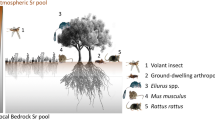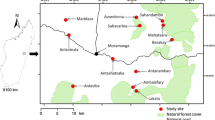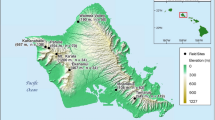Abstract
The diets of sympatric rodents partially define their realized niches. Identifying items in stomachs of introduced rodents helps determine rodents’ trophic positions and species most at risk of consumption. In the Hawaiian Islands, which lacked rodents prior to human arrival, three rodents (Rattus rattus or black rat, R. exulans or Pacific rat, Mus musculus or house mouse) commonly coexist in native habitats where they consume a wide range of plants and animals. These three rodent species were trapped in montane forest for 2.5 years; their stomach contents were analyzed to determine short-term diets (n = 12–95 indiv. per species), and isotopic fractions of δ15N and δ13C in their bone collagen were analyzed to further estimate their trophic positions (n = 11–20 indiv. per species). For all three species, >75 % of individuals had plants and >90 % had arthropods in their stomachs, and significant differences in mean relative abundances were found for food items in stomachs among all three rodents. Rodents may be dispersing some native and non-native seeds, including the highly invasive Clidemia hirta. Most identifiable arthropods in rodent stomachs were non-native, and no stomachs contained birds, snails, or lizards. The δ15N and δ13C signatures were consistent with trophic feeding differences revealed from stomach contents. Dietary niche differentiation by coexisting rodent species is evident in this forest, with Pacific rats being intermediate between the mostly carnivorous house mouse and the mostly herbivorous black rat; such findings can help forecast rodent impacts and direct management efforts in ecosystems where these invasive animals coexist.



Similar content being viewed by others
References
Amarasekare P (1994) Ecology of introduced small mammals on western Mauna Kea, Hawaii. J Mammal 75:24–38
Angel A, Wanless RM, Cooper J (2009) Review of impacts of the introduced house mouse on islands in the Southern Ocean: are mice equivalent to rats? Biol Invasions 11:1743–1754
Atkinson IAE, Towns DR (2005) Kiore. In: King CM (ed) The handbook of New Zealand mammals, 2nd edn. Oxford University Press, UK, pp 159–174
Beard KH, Pitt WC (2006) Potential predators of an invasive frog (Eleutherodactylus coqui) in Hawaiian forests. J Trop Ecol 22:345–347
Biró Z, Lanszki J, Szemethy L, Heltai M, Randi E (2005) Feeding habits of feral domestic cats (Felis catus), wild cats (Felis sylvestris) and their hybrids: trophic niche overlap among cat groups in Hungary. J Zool 266:187–196
Bonnaud E, Medina FM, Vidal E, Nogales M, Tershy B, Zavaleta E, Donlan CJ, Keitt B, Le Corre M, Horwath SV (2011) The diet of feral cats on islands: a review and call for more studies. Biol Invasions 13:581–603
Bunn TJ, Craig JL (1989) Population cycles of Rattus exulans: population changes, diet, and food availability. NZ J Zool 16:409–418
Caut S, Angulo E, Courchamp F (2008a) Dietary shifts of an invasive predator: rats, seabirds and turtles. J Appl Ecol 45:428–437
Caut S, Angulo E, Courchamp F (2008b) Discrimination factors (∆15N and ∆13C) in an omnivorous consumer: effect of diet isotopic ratio. Func Ecol 22:255–263
Caut S, Angulo E, Courchamp F (2009) Variation in discrimination factors (∆15N and ∆13C): the effect of diet isotopic values and applications for diet reconstruction. J Appl Ecol 46:443–453
Clark DA (1981) Foraging patterns of black rats across a desert-montane forest gradient in the Galapágos Islands. Biotropica 13:182–194
Clark DA (1982) Foraging behavior of a vertebrate omnivore (Rattus rattus): meal structure sampling, and diet breadth. Ecology 63:763–772
Cole FR, Loope LL, Medeiros AC, Howe CE, Anderson LJ (2000) Food habits of introduced rodents in high-elevation shrubland of Haleakala National Park, Maui, Hawaii. Pac Sci 54:313–329
Drake DR, Hunt TL (2009) Invasive rodents on islands: integrating historical and contemporary ecology. Biol Invasions 11:1483–1487
Drake DR, Bodey T, Russell J, Towns D, Nogales M, Ruffino L (2011) Direct impacts of seabird predators on island biota other than seabirds. In: Mulder CPH, Anderson WB, Towns DR, Bellingham PJ (eds) Seabird Islands: ecology, invasion and restoration. Oxford University Press, UK, pp 91–132
Eadie JM, Broekhoven L, Colgan P (1987) Size ratios and artifacts: Hutchinson’s rule revisited. Am Nat 129:1–17
Elton C (1927) Animal ecology. Sedgwick and Jackson, London
Fritts TH, Rodda GH (1998) The role of introduced species in the degradation of island ecosystems: a case history of Guam. Ann Rev Ecol Syst 29:113–140
Fukami T, Wardle DA, Bellingham PJ, Mulder CPH, Towns DR, Yeates GW, Bonner KI, Durrett MS, Grant-Hoffman MN, Williamson WM (2006) Above- and below-ground impacts of introduced predators in seabird-dominated island ecosystems. Ecol Lett 9:1299–1307
Gales RP (1982) Age- and sex-related differences in diet selection by Rattus rattus on Stewart Island, New Zealand. NZ J Zool 9:463–466
Gannes LZ, O’Brien DM, del Rio CM (1997) Stable isotopes in animal ecology: assumptions, caveats, and a call for more laboratory experiments. Ecology 78:1271–1276
Gause GF (1934) The struggle for existence. Hafner, New York
Giambelluca TW, Chen Q, Frazier AG, Price JP, Chen Y-L, Chu P-S, Eischeid J, Delparte D (2011) The Rainfall Atlas of Hawai‘i. http://rainfall.geography.hawaii.edu. Accessed May 9, 2012
Harper GA (2006) Habitat use by three rat species (Rattus spp.) on an island without other mammalian predators. NZ J Ecol 30:321–333
Harper GA, Cabrera LF (2010) Response of mice (Mus musculus) to the removal of black rats (Rattus rattus) in arid forest on Santa Cruz Island, Galápagos. Biol Invasions 12:1449–1452
Harris DB, Macdonald DW (2007) Interference competition between introduced black rats and endemic Galapagos rice rats. Ecology 88:2330–2344
Hutchinson GE (1957) Concluding remarks. Cold Spring Harbor Symposium Quant Biol 22:415–427
Hutchinson GE (1959) Homage to Santa Rosalia, or why are there so many kinds of animals? Am Nat 93:145–159
Innes J (2005) Ship rat. In: King CM (ed) The handbook of New Zealand mammals, 2nd edn. Oxford University Press, UK, pp 187–203
Joe SM, Daehler CC (2008) Invasive slugs as underappreciated obstacles to rare plant restoration: evidence from the Hawaiian Islands. Biol Invasions 10:245–255
Kami HT (1966) Foods of rodents in the Hamakua District, Hawaii. Pac Sci 20:367–373
Kotler BP, Brown JS (1988) Environmental heterogeneity and the coexistence of desert rodents. Ann Rev Ecol Syst 19:281–307
Lajtha K, Michener RH (1994) Stable isotopes in ecology and environmental science. Blackwell Scientific Publications, Oxford
Lindsey GD, Mosher SM, Fancy SG, Smucker TD (1999) Population structure and movements of introduced rats in an Hawaiian rainforest. Pac Conserv Biol 5:94–102
McConkey KR, Drake DR, Meehan HJ, Parsons N (2003) Husking stations provide evidence of seed predation by introduced rodents in Tongan rain forests. Biol Conserv 109:221–225
Meyer WM, Shiels AB (2009) Black rat (Rattus rattus) predation on non-indigenous snails in Hawai`i: complex management implications. Pac Sci 63:339–347
Miller AP, Webb PI (2001) Diet of house mice (Mus musculus L.) on coastal sand dunes, Otago, New Zealand. NZ J Ecol 28:49–55
Mosby J, Wodzicki K, Thompson HR (1973) Food of the kimoa (Rattus exulans) in the Tokelau islands and other habitats in the Pacific. NZ J Sci 16:799–810
Norman FI (1970) Food preferences of an insular population of Rattus rattus. J Zool London 162:493–503
Pender RJ, Shiels AB, Bialic-Murphy L, Mosher SM (in press) Large-scale rodent control reduces pre- and post-dispersal seed predation of the endangered Hawaiian lobeliad, Cyanea superba subsp. superba (Campanulaceae). Biol Invasions. doi:10.1007/s10530-012-0280-3
Pérez HE, Shiels AB, Zaleski HM, Drake DR (2008) Germination after simulated rat damage in seeds of two endemic Hawaiian palm species. J Trop Ecol 24:555–558
Peterson BJ, Fry B (1987) Stable isotopes in ecosystem studies. Ann Rev Ecol Syst 18:293–320
Phillips DL (2012) Converting isotope values to diet composition: the use of mixing models. J of Mammal 93:342–352
Pisanu B, Caut S, Gutjar S, Vernon P, Chapuis J-L (2011) Introduced black rats (Rattus rattus) on Ile de la Possession (Iles Crozet, Subantarctic): diet and trophic position in food webs. Polar Biol 34:169–180
Post DM (2002) Using stable isotopes to estimate trophic position: models, methods, and assumptions. Ecology 83:703–718
Quillfeldt P, Schenk I, McGill RAR, Strange IJ, Masello JF, Gladbach A, Roesch V, Furness RW (2008) Introduced mammals coexist with seabirds at New Island, Falkland Islands: abundance, habitat preferences, and stable isotope analysis of diet. Polar Biol 31:333–349
R Development Core Team (2010) R: a language and environment for statistical computing. The R Foundation for Statistical Computing, Vienna
Rowe-Rowe DT, Green B, Crafford JE (1989) Estimated impact of the feral house mouse on sub-Antarctic invertebrates at Marion Island. Polar Biol 9:457–460
Ruffino L, Russell JC, Pisanu B, Caut S, Vidal E (2011) Low individual-level dietary plasticity in an island-invasive generalist forager. Pop Ecol 53:535–548
Ruscoe WA, Murphy EC (2005) House mouse. In: King CA (ed) The handbook of New Zealand mammals. Oxford University Press, UK, pp 204–221
Ruscoe WA, Ramsey DSL, Pech RP, Sweetapple PJ, Yockney I, Barron MC, Perry M, Nugent G, Carran R, Warne R, Brausch C, Duncan RP (2011) Unexpected consequences of control: competitive vs. predator release in a four-species assemblage of invasive mammals. Ecol Lett 14:1035–1042
Russell JC, Clout MN (2004) Modeling the distribution and interaction of introduced rodents on New Zealand offshore islands. Global Ecol Biogeogr 13:497–507
Shiels AB (2010) Ecology and impacts of introduced rodents (Rattus spp. and Mus musculus) in the Hawaiian Islands. Dissertation, Department of Botany, University of Hawaii at Manoa
Shiels AB (2011) Frugivory by introduced black rats (Rattus rattus) promotes dispersal of invasive plant seeds. Biol Invasions 13:781–792
Shiels AB, Drake DR (2011) Are introduced rats (Rattus rattus) both seed predators and dispersers in Hawaii? Biol Invasions 13:883–894
St Clair JJH (2011) The impacts of invasive rodents on island invertebrates. Biol Conserv 144:68–81
Stapp P (2002) Stable isotopes reveal evidence of predation by ship rats on seabirds on the Shiant Islands, Scotland. J Appl Ecol 39:831–840
Stokes VL, Banks PB, Pech RP, Spratt DM (2009) Competition in an invaded rodent community reveals black rats as threats to native bush rats in littoral rainforest of south-eastern Australia. J Appl Ecol 46:1239–1247
Sugihara RT (1997) Abundance and diets of rats in two Hawaiian forests. Pac Sci 51:189–198
Sweetapple PJ, Nugent G (2007) Ship rat demography and diet following possum control in a mixed podocarp-hardwood forest. N Z J Ecol 31:186–201
Towns DR, Atkinson IAE, Daugherty CH (2006) Have the harmful effects of rats on islands been exaggerated? Biol Invasions 8:863–891
Williams PA, Karl BJ, Bannister P, Lee WG (2000) Small mammals as potential seed dispersers in New Zealand. Austral Ecol 25:523–532
Wilmshurst JM, Hunt TL, Lipo CP, Anderson AJ (2011) High precision radiocarbon dating shows recent and rapid initial human colonization of East Polynesia. Proc Natl Acad Sci 108:1815–1820
Wirtz WO (1972) Population ecology of the Polynesian rat, Rattus exulans, on Kure Atoll, Hawaii. Pac Sci 26:443–463
Yom-Tov Y, Yom-Tov S, Moller H (1999) Competition, coexistence, and adaptation amongst rodent invaders to Pacific and New Zealand islands. J Biogeogr 26:947–958
Acknowledgments
Primary funding was provided by the Oahu Army Natural Resources Program; additional funding to A.B.S. was from the Achievement Rewards for College Scientists (Maybell Roth Scholarship in Conservation Biology and Sarah Martin Award in Botany), the Charles Lamoureux Plant Conservation Fellowship, and the Watson Yoshimoto Wildlife Conservation Scholarship. Thanks to K. Kawelo, D. Peters, J. Rohrer, and L. Wilson for assistance capturing rodents, J. Liebherr for the B. epicurus identification, and C. Daehler, T. Hunt, and two anonymous reviewers for helpful comments on an earlier draft of this manuscript. This research was approved by the University of Hawaii Animal Use and Care Committee.
Author information
Authors and Affiliations
Corresponding author
Rights and permissions
About this article
Cite this article
Shiels, A.B., Flores, C.A., Khamsing, A. et al. Dietary niche differentiation among three species of invasive rodents (Rattus rattus, R. exulans, Mus musculus). Biol Invasions 15, 1037–1048 (2013). https://doi.org/10.1007/s10530-012-0348-0
Received:
Accepted:
Published:
Issue Date:
DOI: https://doi.org/10.1007/s10530-012-0348-0




